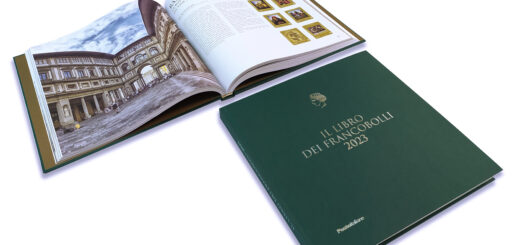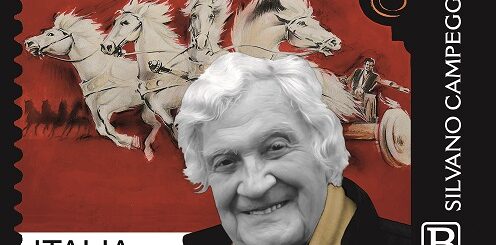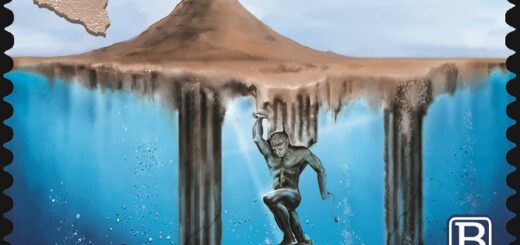POSTE ITALIANE 6^ emissione anno 2019 “francobollo commemorativo di Francesco Morosini nel IV centenario della nascita”
Il Ministero emette il 26 febbraio 2019 un francobollo commemorativo di Francesco Morosini nel IV centenario della nascita relativo al valore della tariffa B.
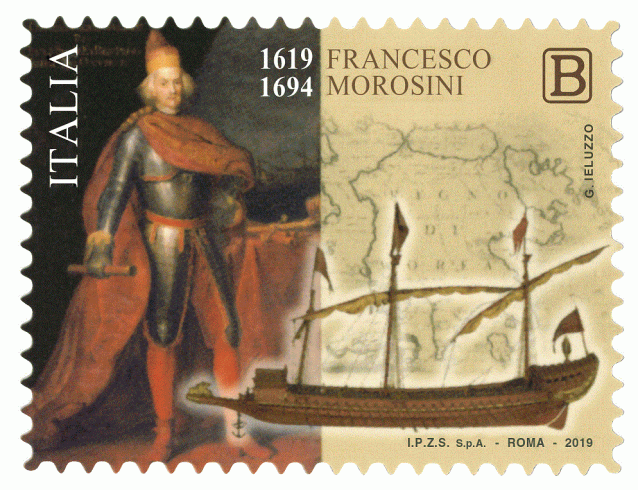
Francesco Morosini, anche noto come il Peloponnesiaco (Venezia, 26 febbraio 1619 – Nauplia, 6 gennaio 1694), è stato il 108º doge della Repubblica di Venezia dal 3 aprile 1688 fino alla sua morte.
Biografia
Figlio di Pietro e di Maria Morosini, la vita di Francesco Morosini, Forse il rapporto difficile con la nuova matrigna fecero nascere in lui uno spirito ribelle e militaresco. Tuttavia il legame di parentela gli facilitò sicuramente l’ingresso nella flotta della Repubblica veneziana su di una galea comandata dal suo secondo cugino Pietro Badoer, ammiraglio a Candia. Indirizzato a studi classici, si mostrò più interessato a battaglie e strategie, arruolandosi molto presto nelle armate venete. Troppo preso dalle armi non si sposò mai. Aveva due fratelli e un fratellastro.
Carriera militare
Giovane marinaio durante gli anni trenta del secolo, furono lo scoppio della guerra contro i turchi nel 1644 e la notevole fortuna della sua famiglia che gli permisero di dar sfogo ai suoi istinti e alle sue capacità in modo completo. Perduta quasi interamente l’isola di Creta, rimase ai veneziani solo una città, Candia, la capitale, che venne prontamente assediata dai nemici. Nominato comandante delle forze terrestri nella città per ben due volte (1646-1661 e 1667-1669) riuscì a galvanizzare le sue truppe a tal punto da riuscire a farle resistere per ben 23 anni. Le spaventose battaglie ridussero la città ad un cumulo di macerie e riempirono i cimiteri militari dell’isola (tra i veneziani i morti furono circa 30.000, tra i turchi 80.000) senza che la situazione mutasse in modo sostanziale.
Il 6 settembre 1669, vista l’oggettiva impossibilità di proseguire la resistenza, il Morosini firmò la pace con il nemico e cedette la città, ormai abitata da poche migliaia di persone. Per via della strenua resistenza di Candia, i Veneziani ottennero una pace a condizioni onorevoli: I superstiti poterono abbandonare la città con l’onore delle armi e delle bandiere, mantenere la loro artiglieria, la Repubblica, dietro pagamento di una somma in danaro, conservava a Creta le fortezze della Suda, di Spinalonga e Carabusa e otteneva Clissa in Dalmazia. Infine, i turchi si impegnavano a non entrare nella città se non in capo a 12 giorni, e a lasciar partire liberamente tutti coloro che lo volevano
La sua eccessiva autonomia (e un uso disinvolto del denaro pubblico) gli costò un processo nel 1670 per insubordinazione ed appropriazione indebita da cui, però, uscì scagionato. Con la fine della guerra e la relativa calma che ne seguì, venne trasferito per qualche tempo in Friuli. Pareva l’inizio del suo congedo dopo una gioventù piena di successi e privilegi, ma la Repubblica, pur prostrata economicamente e militarmente, non accettando il trattato del 1669, colse al balzo l’occasione offerta dall’entrata in guerra della Turchia contro l’Austria nel 1683 ed allestì una flotta per vendicarsi degli affronti subiti.
Il Morosini, uno degli ultimi grandi comandanti veneziani, venne subito nominato a capo di essa. Negli anni che seguirono (1683-1687), con una flotta relativamente piccola e con equipaggi di media qualità, riuscì a compiere imprese mirabili, con conquiste di isole e fortezze ritenute imprendibili.
Vinse a ripetizione e minacciò i cardini dell’Impero turco nel Mar Mediterraneo. Nel 1684 conquista l’isola di Santa Maura; nel 1685 occupa Corone e la Maina; nel 1686, con il suo luogotenente Königsmarck, uno svedese entrato al servizio della Repubblica, prendeva Navarino, Modone, Argo, Nauplia; nel 1687 tutta la Morea, salvo Malvasia e Mistrà, era in mano sua; poi si impadroniva di Patrasso e di Lepanto, di Corinto e di Atene.
Durante l’assedio di Atene, un colpo di mortaio distrusse in parte il Partenone, ridotto dai turchi a polveriera. Fu in quell’occasione che crollò il tetto del tempio, che fino ad allora era rimasto miracolosamente intatto. Si suol dire del genio di Morosini: Con un sol colpo di mortaio distrusse la polveriera turca.
L’11 agosto 1687, per i meriti ottenuti sul campo di battaglia, ottenne dal Senato veneziano (cosa mai accaduta né prima né dopo) il titolo di Peloponnesiaco, oltre a un busto in bronzo in suo onore che venne posto nella sala del Consiglio dei Dieci. L’iscrizione sotto al busto riportava: “Il Senato a Francesco Morosini, il Peloponnesiaco, ancora in vita”.
Dogato
Rifiutata una sua candidatura nel 1684, alla morte di Marcantonio Giustinian (23 marzo 1688) il 3 aprile del 1688 venne eletto doge. La notizia gli giunse durante un assedio e, per onorarlo, la sua incoronazione avvenne tra i suoi soldati entusiasti. Tornato a Venezia solo nel 1691 il Morosini, stanco dopo tante spedizioni, poté godere di trattamenti di favore e privilegi mai concessi in precedenza. Durante questo periodo si osservò in lui una certa vanità eccessiva che offuscò un po’ la fama di grande uomo che aveva ottenuto con le sue vittorie, fama confermata nel 1689 dal dono dello stocco pontificio da parte del veneziano Papa Alessandro VIII. Troppo arrogante per i nobili e i senatori e troppo vanitoso per il popolo, si decise di inviarlo nuovamente alla testa delle sue truppe visto che i generali che lo avevano sostituito non si erano mostrati all’altezza. Nel maggio 1693 partì da Venezia con la sua flotta tra ali osannanti di folla, e subito si gettò a capofitto in battaglie ed assedi riprendendo a vincere (ben tre battaglie in pochi mesi). Il Morosini però era vecchio, e non riusciva più a reggere il peso fisico e morale d’una spedizione militare. Ammalatosi, venne portato nella città peloponnesiaca di Nauplia, dove morì il 6 gennaio 1694.
I suoi organi interni furono sepolti nella chiesa di Sant’Antonio a Nauplia, il suo corpo nella chiesa di Santo Stefano a Venezia. Nel suo testamento lasciò la sua fortuna ai figli dei fratelli, non avendo egli discendenti diretti, solo a patto che chiamassero Francesco tutti i loro figli maschi per sempre, ultimo segno d’una vanità che confinava con l’arroganza.
Se sei interessato ad acquistare questo francobollo, lo puoi acquistare al prezzo di € 1.40. Inviami una richiesta alla email: protofilia1@gmail.com
If you are interested in buying this stamp, you can buy it for € 1.40. Send me a request to the email: protofilia1@gmail.com
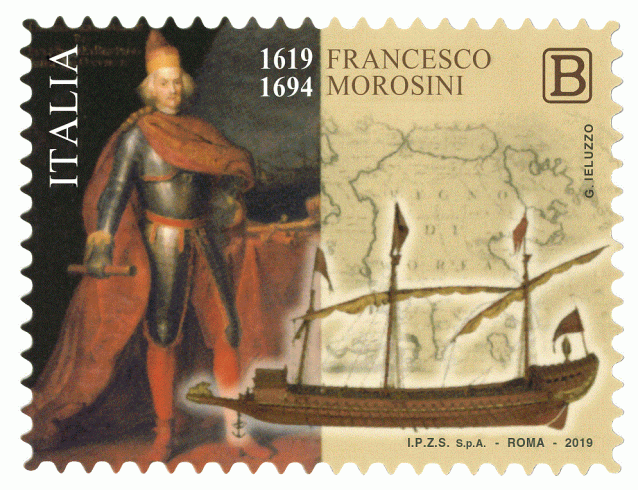
Title: commemorative stamp of Francesco Morosini on the fourth centenary of his birth
Francesco Morosini, also known as the Peloponnesia (Venice, 26 February 1619 – Nauplia, 6 January 1694), was the 108th Doge of the Venetian Republic from 3 April 1688 until his death.
Biography
Son of Peter and Maria Morosini, the life of Francesco Morosini, Perhaps the difficult relationship with the new stepmother gave rise to a rebellious and militaristic spirit in him. However, the kinship certainly facilitated the entry into the Venetian Republic fleet on a galea commanded by his second cousin Pietro Badoer, admiral in Candia. Indirect to classical studies, he showed himself more interested in battles and strategies, enlisting very early in the Venetian armies. Too taken from arms he never married. He had two brothers and a half brother.
Military career
Young sailor in the thirties of the century, were the outbreak of war against the Turks in 1644 and the remarkable fortune of his family that allowed him to give vent to his instincts and his skills in a comprehensive manner. Almost entirely lost the island of Crete, only one city remained to the Venetians, Candia, the capital, which was promptly besieged by its enemies. Appointed commander of the terrestrial forces in the city twice (1646-1661 and 1667-1669) he managed to galvanize his troops to the point of being able to resist them for 23 years. The terrible battles reduced the city to a pile of rubble and filled the military cemeteries of the island (among the Venetians there were about 30,000 dead, among the 80,000 Turks) without the situation changing substantially.
On 6 September 1669, given the objective impossibility of continuing the resistance, Morosini signed the peace with the enemy and ceded the city, now inhabited by a few thousand people. Because of the strenuous resistance of Candia, the Venetians obtained a peace on honorable terms: The survivors could leave the city with the honor of arms and flags, keep their artillery, the Republic, on payment of a sum in money, kept in Crete the fortresses of Suda, Spinalonga and Carabusa and obtained Clissa in Dalmatia. Finally, the Turks committed themselves not to enter the city except for 12 days, and to let everyone who wanted
His excessive autonomy (and the casual use of public money) cost him a trial in 1670 for insubordination and embezzlement from which, however, he was exonerated. With the end of the war and the relative calm that followed, he was transferred for some time to Friuli. It seemed like the beginning of his leave after a youth full of successes and privileges, but the Republic, despite its economic and military prostration, not accepting the 1669 treaty, took the opportunity offered by Turkey’s entry into the war against the Austria in 1683 and set up a fleet to take revenge for the insults suffered.
The Morosini, one of the last great Venetian commanders, was immediately appointed to head of it. In the years that followed (1683-1687), with a relatively small fleet and with crews of medium quality, he managed to accomplish wonderful businesses, with conquests of islands and fortresses considered impregnable.
He won repeatedly and threatened the hinges of the Turkish Empire in the Mediterranean Sea. In 1684 he conquered the island of Santa Maura; in 1685 he occupied Corone and la Maina; in 1686, with his lieutenant Königsmarck, a Swede entered the service of the Republic, he took Navarino, Modone, Argo, Nauplia; in 1687 all the Morea, except Malvasia and Mistrà, was in his hands; then he took possession of Patras and Lepanto, Corinth and Athens.
During the siege of Athens, a mortar shell partially destroyed the Parthenon, reduced by the Turks to a powder magazine. It was on that occasion that the roof of the temple collapsed, which until then had remained miraculously intact. They say of the genius of Morosini: With a single mortar blow he destroyed the Turkish powder keg.
On 11 August 1687, for the merits obtained on the battlefield, he obtained from the Venetian Senate (something that happened before or after) the title of Peloponnesia, in addition to a bronze bust in his honor that was placed in the Council Chamber Ten. The inscription under the bust reported: “The Senate to Francesco Morosini, the Peloponnesian, still alive”.
Dogato
Rejected his candidacy in 1684, on the death of Marcantonio Giustinian (23 March 1688) on 3 April 1688 he was elected doge. The news came to him during a siege and, to honor him, his coronation took place among his enthusiastic soldiers. Returning to Venice only in 1691, Morosini, tired after many expeditions, could enjoy preferential treatment and privileges never granted before. During this period he observed in him a certain excessive vanity that clouded a bit ‘fame of the great man who had obtained with his victories, fame confirmed in 1689 by the gift of papal stocco by the Venetian Pope Alexander VIII.
Too arrogant for the nobles and senators and too vain for the people, it was decided to send it back to the head of its troops since the generals who had substituted it had not shown up. In May 1693 he left Venice with his fleet among the haunting wings of the crowd, and immediately threw himself headlong into battles and sieges, resuming his victory (three battles in a few months). But the Morosini was old, and could no longer bear the physical and moral weight of a military expedition. When he fell ill, he was taken to the Peloponnesian town of Nauplia, where he died on 6 January 1694.
His internal organs were buried in the church of Sant’Antonio in Nauplia, his body in the church of Santo Stefano in Venice. In his will he left his fortune to the sons of the brothers, having no direct descendants, only on condition that they would call Francis all their sons forever, the last sign of a vanity that bordered on arrogance.
Se sei interessato ad acquistare questo francobollo, lo puoi acquistare al prezzo di € 1.40. Inviami una richiesta alla email: protofilia1@gmail.com
If you are interested in buying this stamp, you can buy it for € 1.40. Send me a request to the email: protofilia1@gmail.com
- data/date 26 Febbraio 2019
- dentellatura/serration 11
- stampa/printing fustellatura/rotocalco
- tipo di carta/paper type bianca patinata neutra
- stampato I.P.Z.S. Roma
- tiratura 2.500.000
- fogli/sheet 45
- dimensioni/dimension 40×30 mm
- disegnatore/designer Gaetano Ieluzzo
- costo/price B= €1.10
- num. catalogo / catalog num. Michel 4091 YT3852 UN3934
